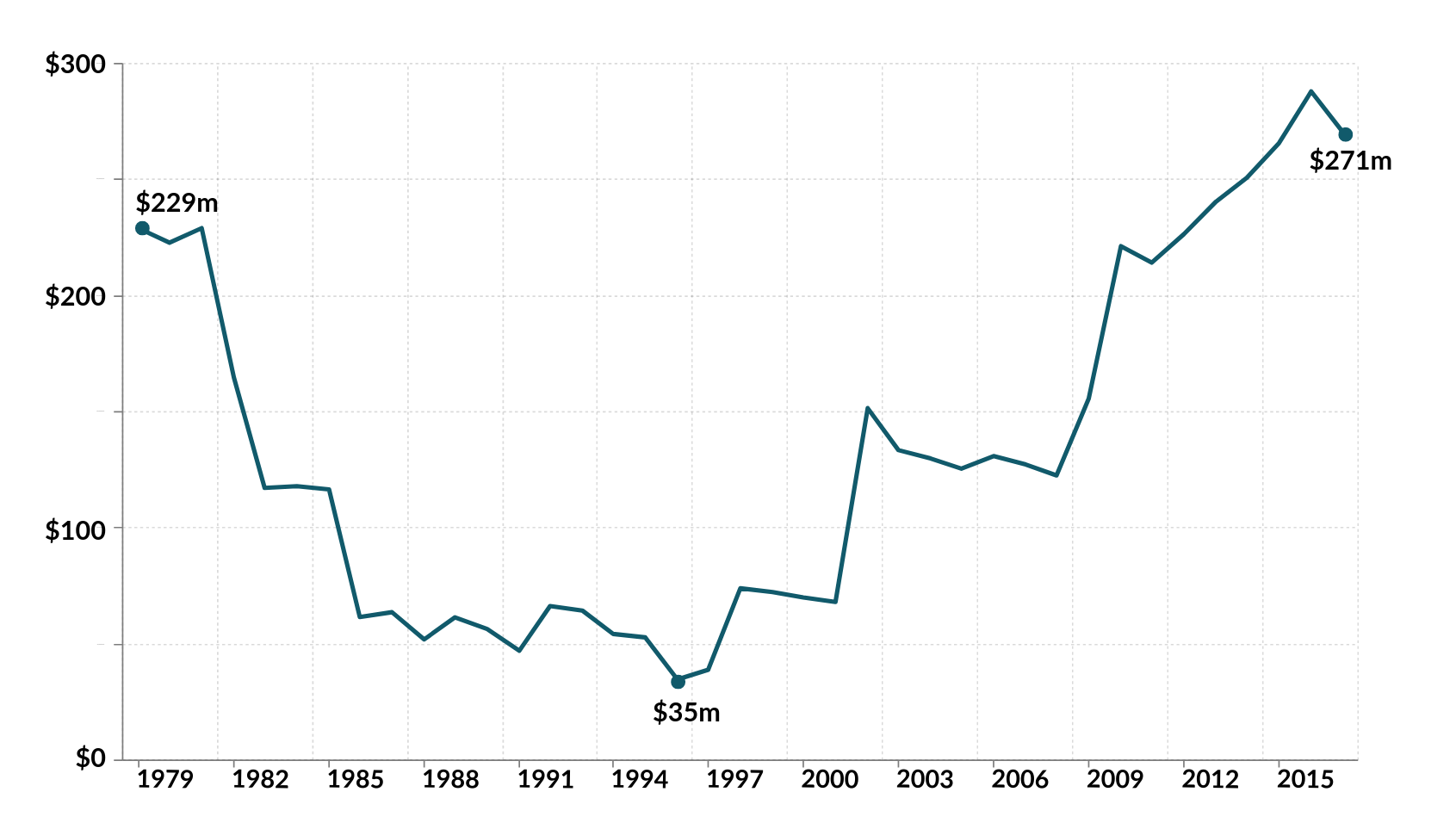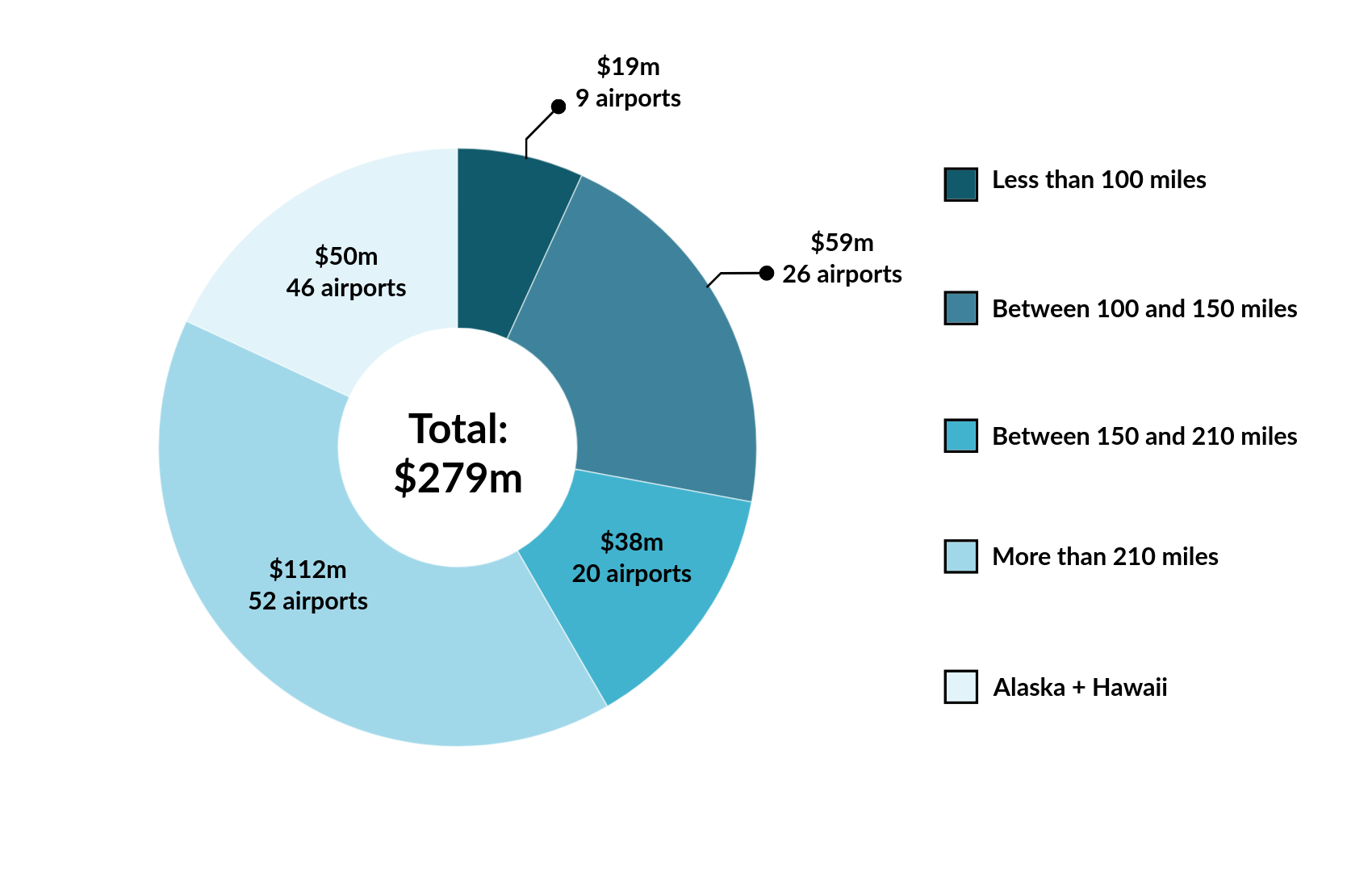Over the past 15 years, changes in the airline industry have consolidated air service at the largest hub airports while passenger levels at medium hubs have remained consistent.[1] But the smallest of airports usually do not have enough demand to maintain commercial air service. So for nearly 40 years, the federal government has been funding air travel to and from small communities across the United States.
In 1979, when the federal government deregulated the airline industry, Congress established the Essential Air Service Program (EAS) to subsidize flights to the smallest airports. The busiest of those airports, Joplin, Missouri, has on average fewer than 160 passengers per day.[2] Some EAS airports have fewer than a dozen passengers departing per day.
The program was initially intended to last only 10 years, but was extended in perpetuity in 1996. Since then, program costs have risen significantly (Figure 1).[3]
Figure 1. Essential Air Service spending in millions of constant 2016 dollars (1979-2016).

Source: Office of Aviation Analysis, “Essential Air Service,” U.S. Department of Transportation, 2016.
One rationale for the continuation of EAS is that many airports are very far from medium or large hub airports, leaving local residents and businesses without options. Figure 2 shows that EAS airports are scattered across America, but not all are very far from a large or medium hub airport.
Figure 2. Distance to nearest large or medium hub for airports in the Essential Air Service program (continental U.S. only).
On a per-passenger basis, the level of subsidy varies significantly; from close to zero, to several hundred dollars for each passenger flown (Table 1). On the high end of dollars per passenger, 47 percent of the airports within 210 miles of a medium or large hub provide more than $200 per passenger. The highest per passenger subsidy for these airports during FY2016 was received by the airport in Altoona, Pennsylvania. On average, each of the 3,693 passengers that travelled through that airport during FY2016 cost the U.S. Department of Transportation (U.S. DOT) $642.
Table 1. Subsidy per passenger for airports in the Essential Air Service program, (FY2016).
[table id=13 /]
Figure 3. FY2016 spending on Essential Air Service airports, grouped by distance to large or medium hubs (for those in the continental U.S.).

Note: totals might not add up due to rounding.
Source: Office of Aviation Analysis, “Essential Air Service,” U.S. Department of Transportation, 2016.
Since the 1990s, Congress has tried to reign in the EAS program costs by imposing limitations on the program via minimum number of enplanements and caps on subsidies. These measures are to be taken into consideration only for existing service. Current limitations include:
- Limiting the program to communities further than 70 miles from a large or medium hub.
- Requiring a minimum of 10 daily enplanements.
- Capping the per-passenger subsidies at $200 for communities less than 210 miles from a medium or large hub (and $1,000 for the others).
For existing service, U.S. DOT enforced the $200 maximum per passenger subsidy rule between 1990 and 2006, which led to 39 communities losing service during that period. But in 2006 U.S. DOT stopped enforcing the rule.[4] While in 2014 U.S. DOT announced that they would once more enforce the $200 limit, in FY2016 there were still 26 airports above the threshold.[5]
EAS program costs have increased four-fold in real terms in the last 15 years (Figure 1). In fact, U.S. DOT still has criteria for considering adding new communities to EAS, including reliability, connections with other airlines at larger hubs, and community views, but notably none of them include cost.[6]
Aside from cutting the program completely, which the Trump administration proposed in their initial 2018 budget outline (but eventually became a 50 percent reduction in the final version of the budget), Congress and U.S. DOT could consider several options to save money on the program (Table 2):[7]
- Increase the 70-mile minimum distance to a medium or large hub.
- Enforce the $200 per-passenger cap for airports within 210 miles of such a hub.
- Enforce the 10 enplanements per day minimum for airports within 175 miles of medium and large
hubs.
Table 2. Potential annual savings for the EAS program.
[table id=14 /]
Each of the options for reducing the cost of EAS produce only modest savings. Even in a scenario where EAS is only provided to airports that are a minimum of 150 miles from a medium or large hub, the $200 passenger cap is enforced, and the 10 daily enplanements are enforced, the potential savings would only amount to $114.3 million. Additionally, EAS is a relatively small program when compared to the broader federal aviation spending: less than two percent of $16 billion per year.
How does the federal government subsidize air service to small communities?
Answers:
The Essential Air Service program distributes approximately $270 million per year to support commercial air service to small airports. Unfortunately most Americans will never take advantage of this program, as the busiest EAS airport serves on average only 160 passengers per day.
Public subsidies play an important role in guaranteeing air access to many small communities. However, EAS also subsidizes service to communities that have reasonable ground access to medium and large hubs. Rules created to decrease costs associated with the program have not been enforced.
The EAS program could be cut back, but it represents only a small portion of overall federal expenditures in aviation.
Eno Aviation Insights homepage
Question 9: Should the federal government invest heavily in expanding American airports to relieve congestion?
Eno wishes to acknowledge its Aviation Working Group, a standing advisory body that provides Eno staff with guidance and expertise on all matters related to aviation policy. The opinions expressed are those of Eno and do not necessarily reflect the views of our supporters.
[1] “How has air travel in specific metropolitan areas changed in recent years?” Eno Center for Transportation, 2017.
[2] When the program was created there were 746 eligible communities, including 237 in Alaska and nine in Hawaii, but only around 300 of those communities have ever received any subsidized service. See: Jeff Davis, “Trump Budget Battles the Legacy of Regulated Routes,” Eno Transportation Weekly, April 10, 2017.
[3] Researchers have provided several reasons for the dramatic increase in costs. See: Rachel Y. Tang, “Essential Air Service (EAS),” Congressional Research Service, 2015.
[4] Since 2006, only one airport (Brooking, South Dakota), has lost service because it exceed the $200 per passenger subsidy limit. U.S. DOT has, however, kept enforcing the $1,000 per passenger maximum subsidy, and three airports lost service due to that cap in 2016. Since 2012 8 airports lost service because of the $1,000 rule. See U.S. Department of Transportation, “Essential Air Service Communities Eliminated Due to Per-Passenger Subsidy Cap (Updated October 2016),” 2016.
[5] Office of Aviation Analysis, “Notice of Enforcement Policy, $200 Per Passenger Subsidy Cap,” U.S. Department of Transportation, 2014.
[6] Rachel Y. Tang, 2015.
[7] Jeff Davis, “White House Releases Full FY18 Budget Request,” Eno Transportation Weekly, May 23, 2017.



